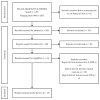Timing of Magnetic Resonance Imaging (MRI) in Moderate and Severe TBI: A Systematic Review
- PMID: 40565823
- PMCID: PMC12194093
- DOI: 10.3390/jcm14124078
Timing of Magnetic Resonance Imaging (MRI) in Moderate and Severe TBI: A Systematic Review
Abstract
Background: Traumatic brain injury (TBI) remains a significant global health concern with a substantial socioeconomic impact. Although computed tomography (CT) is the primary initial neuroimaging technique, magnetic resonance imaging (MRI) offers a superior detection of subtle brain injuries. However, the ideal timing for MRI in critically ill patients with TBI remains unclear. Methods: This systematic literature review focused on the timing and utility of MRI in moderate and severe TBI in the early treatment phase. A comprehensive search was conducted using PubMed, employing specific search terms related to MRI timing and prognostication in TBI. The mean duration from admission to first MRI was examined in the conducting medical center for reference. Results: Early MRI, within 72 h post-injury, demonstrated a prognostic value compared with later scans. Diffusion tensor imaging (DTI) performed within 48 to 72 h captured critical pathophysiological changes. The presence of bilateral traumatic axonal injury in the brainstem or thalami on MRI served as a significant predictor of outcome in severe TBI. In pediatric TBI, most institutions performed MRI between seventy-two hours and two weeks post-injury, highlighting variability in practices. The mean interval until the first MRI at the conducting center was 16 days. Conclusions: MRI appears to be a valuable tool for prognostication in moderate to severe TBI, offering additional insights beyond those provided by CT. However, the optimal timing and modality for accurate diagnostic and prognostic utility remain uncertain. Current evidence suggests that MRI performed within 72 h after injury in ICU-treated patients with moderate and severe TBI offers valuable prognostic insights compared with delayed MRI, although further research is needed to establish standardized timing protocols and confirm the clinical impact.
Keywords: TBI; magnetic resonance imaging; moderate TBI; pediatric TBI; severe TBI; traumatic brain injury.
Conflict of interest statement
The authors declare no conflicts of interest.
Figures
Similar articles
-
Structural neuroimaging in psychosis: a systematic review and economic evaluation.Health Technol Assess. 2008 May;12(18):iii-iv, ix-163. doi: 10.3310/hta12180. Health Technol Assess. 2008. PMID: 18462577
-
Systemic pharmacological treatments for chronic plaque psoriasis: a network meta-analysis.Cochrane Database Syst Rev. 2021 Apr 19;4(4):CD011535. doi: 10.1002/14651858.CD011535.pub4. Cochrane Database Syst Rev. 2021. Update in: Cochrane Database Syst Rev. 2022 May 23;5:CD011535. doi: 10.1002/14651858.CD011535.pub5. PMID: 33871055 Free PMC article. Updated.
-
Isolated Traumatic Subarachnoid Hemorrhage on Head Computed Tomography Scan May Not Be Isolated: A Transforming Research and Clinical Knowledge in Traumatic Brain Injury Study (TRACK-TBI) Study.J Neurotrauma. 2024 Jun;41(11-12):1310-1322. doi: 10.1089/neu.2023.0253. Epub 2024 Apr 11. J Neurotrauma. 2024. PMID: 38450561 Free PMC article.
-
Magnetic resonance perfusion for differentiating low-grade from high-grade gliomas at first presentation.Cochrane Database Syst Rev. 2018 Jan 22;1(1):CD011551. doi: 10.1002/14651858.CD011551.pub2. Cochrane Database Syst Rev. 2018. PMID: 29357120 Free PMC article.
-
Cost-effectiveness of using prognostic information to select women with breast cancer for adjuvant systemic therapy.Health Technol Assess. 2006 Sep;10(34):iii-iv, ix-xi, 1-204. doi: 10.3310/hta10340. Health Technol Assess. 2006. PMID: 16959170
References
-
- Hawryluk G.W.J., Rubiano A.M., Totten A.M., O’Reilly C., Ullman J.S., Bratton S.L., Chesnut R., Harris O.A., Kissoon N., Shutter L., et al. Guidelines for the Management of Severe Traumatic Brain Injury: 2020 Update of the Decompressive Craniectomy Recommendations. Neurosurgery. 2020;87:427–434. doi: 10.1093/neuros/nyaa278. - DOI - PMC - PubMed
-
- Maas A.I.R., Menon D.K., Manley G.T., Abrams M., Åkerlund C., Andelic N., Aries M., Bashford T., Bell M.J., Bodien Y.G., et al. Traumatic brain injury: Progress and challenges in prevention, clinical care, and research. Lancet Neurol. 2022;21:1004–1060. doi: 10.1016/S1474-4422(22)00309-X. - DOI - PMC - PubMed
-
- Pease M., Arefan D., Barber J., Yuh E., Puccio A., Hochberger K., Nwachuku E., Roy S., Casillo S., Temkin N., et al. Outcome Prediction in Patients with Severe Traumatic Brain Injury Using Deep Learning from Head CT Scans. Radiology. 2022;304:385–394. doi: 10.1148/radiol.212181. - DOI - PMC - PubMed
Publication types
LinkOut - more resources
Full Text Sources


